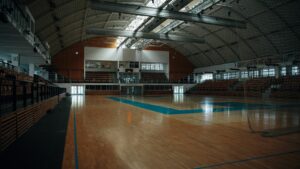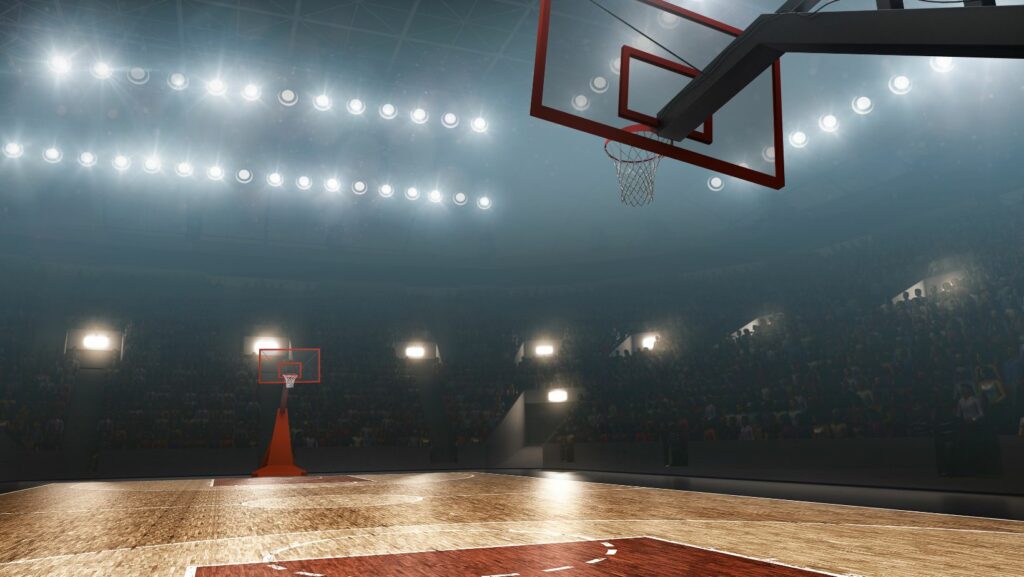Basketball Court
- Court Types and Surfaces: Basketball courts vary from indoor hardwood to outdoor asphalt or concrete, each influencing gameplay style and player performance.
- Standard Dimensions: Professional courts measure 94 feet by 50 feet, while high school courts are slightly smaller (84 feet by 50 feet), impacting game dynamics.
- Key Features: Important markings on the court include the three-point line (23.75 feet from the basket), the free throw line (15 feet), and the key area (16 feet wide), all crucial for strategies.
- Materials Matter: The choice of surface material—hardwood for indoor courts and asphalt or concrete for outdoor ones—affects durability, play quality, and player comfort.
- Maintenance is Essential: Regular upkeep is vital for both indoor and outdoor courts to prevent deterioration and ensure safety. This includes cleaning, repairs, and protective measures.
- Cultural Significance: Basketball courts function as community hubs, enhancing social interactions and promoting youth participation in vibrant streetball cultures.
Basketball courts are more than just a playing surface; they’re vibrant arenas where athletes showcase their skills and fans experience the thrill of the game. These courts come in various sizes and surfaces, tailored for different levels of play, from casual street games to professional leagues. Understanding the nuances of a basketball court can enhance both player performance and viewer enjoyment.
Whether it’s the iconic hardwood of an indoor arena or the textured asphalt of an outdoor court, each type offers unique challenges and advantages. Knowing the dimensions, markings, and materials can make a significant difference in gameplay. This article explores the essential features of basketball courts, their evolution, and how they contribute to the sport’s rich culture.
Overview Of Basketball Courts
Basketball courts serve as essential venues for gameplay, competition, and community interaction. Courts typically measure 94 feet long and 50 feet wide for professional regulation games. The surface can vary, primarily ranging from hardwood indoors to asphalt or concrete outdoors. Each type of surface influences play style and player performance.
Key components of a basketball court include the three-point line, free throw line, and the key area, commonly known as the paint. The three-point line typically sits 23.75 feet from the basket, encouraging long-range shooting. The free throw line, positioned 15 feet from the backboard, allows players to score unopposed during free throws. The key area, measuring 16 feet wide, promotes post play and rebounding strategies.
Lighting and playing conditions vary significantly between indoor and outdoor courts. Indoor courts often feature advanced lighting systems, ensuring consistent visibility, while outdoor courts depend on natural light, which can impact gameplay. Additionally, outdoor surfaces may deteriorate over time, presenting challenges such as uneven surfaces and weather exposure.
Basketball courts also reflect cultural significance, often serving as community hubs. Many urban areas have public courts, promoting accessibility and encouraging youth participation. Streetball culture thrives in these outdoor settings, showcasing unique styles and informal competitions. Some courts even feature custom print posters of local legends, adding a personal touch to the environment and celebrating basketball’s deep community roots.
Understanding the characteristics of basketball courts enhances appreciation for the sport, influencing player strategies and fan engagement.
Types Of Basketball Courts
Basketball courts come in various types, each designed for specific environments and purposes. Understanding these differences enhances the overall experience of playing and watching the game.
Indoor Basketball Courts
Indoor basketball courts are primarily found in gyms, schools, and sports complexes. They feature wooden floors, typically hardwood, which provide optimal bounce for the ball and traction for players. Key elements include controlled lighting, high ceilings, and climate control, allowing for year-round play. Indoor courts often follow standard dimensions of 94 feet in length and 50 feet in width, accommodating professional games. They frequently incorporate spectator seating and scoreboards, enhancing the competitive atmosphere.
Outdoor Basketball Courts
Outdoor basketball courts are commonly located in parks, schools, and urban areas. They usually consist of asphalt or concrete surfaces, promoting durability against various weather conditions. These courts often have simpler construction and may vary in size. Standard dimensions for outdoor courts mirror indoor specifications, but they can also be smaller in community settings. Lighting options may be limited, impacting play during dusk or nighttime. Streetball culture thrives on outdoor courts, providing informal gameplay and community interaction.
Design And Dimensions
Basketball court design encompasses specific dimensions and features that affect gameplay. Understanding these elements enhances gameplay quality and player experience.
Standard Court Size
The standard basketball court size for professional games measures 94 feet long and 50 feet wide. This dimension allows ample space for play, accommodating athletes and spectators alike. In high school and college settings, courts typically measure 84 feet long and 50 feet wide, providing a slightly smaller area without compromising game dynamics. Recreational or community courts often vary in size based on available space, with some measuring as small as 74 feet long, impacting the style of play.
Key Features
Key features of a basketball court include several essential lines and areas that influence gameplay.
- Three-Point Line: The distance from the basket determines shooting strategy, set at 23.75 feet (22.15 feet in the corners) for professional play.
- Free Throw Line: Positioned 15 feet from the backboard, this line is crucial for free throw attempts, requiring shooters to demonstrate accuracy under pressure.
- Key Area (Paint): The key, or paint, measures 16 feet wide and extends from the baseline to the free throw line, playing a vital role in offensive and defensive strategies.
- Basket Height: The rim stands at a height of 10 feet, a consistent height across all levels of play, challenging athletes to perfect their shooting techniques.
These dimensions and features collectively shape the basketball experience, impacting training, performance, and competitive play.
Materials Used In Construction
Basketball courts utilize various materials that impact play quality and durability. Each surface type caters to different environments and player needs.
Hardwood
Hardwood is the material of choice for indoor basketball courts. It offers excellent ball bounce and traction. Common hardwoods include maple and oak, selected for their strength and resilience. Typically, manufacturers treat hardwood floors with a gloss finish to enhance durability and reduce wear.
Asphalt
Asphalt serves as the primary material for outdoor courts. Its resistance to weather conditions makes it ideal for outdoor settings. While asphalt provides a reliable playing surface, its hardness can affect players’ joints over time.
Concrete
Concrete is frequently used in outdoor basketball courts, especially in community spaces. It offers robustness and can withstand harsh environmental conditions. However, concrete surfaces may require additional treatment to improve grip and reduce slipperiness during wet conditions.
Synthetic Materials
Synthetic materials, including polyurethane and acrylic, are becoming increasingly popular for both indoor and outdoor courts. These materials offer a versatile option that combines durability with player comfort. Surfaces made from these materials provide consistent bounce and can be customized for color and performance features.
Markings and Lines
Court markings use paint specifically designed to withstand wear and environmental exposure. Reflective paint ensures visibility during evening games. The application of these markings requires precision to maintain regulation dimensions and enhance gameplay.
Understanding the materials used in constructing basketball courts reveals their influence on playing conditions and overall performance.
Maintenance And Durability
Maintenance is crucial for ensuring the longevity and performance of basketball courts. Regular upkeep helps prevent surface deterioration and safety hazards.
Indoor Court Maintenance
Indoor courts need specific care to maintain hardwood surfaces. Regular cleaning with specialized wood floor cleaners removes dust and debris. Inspecting for damage, such as scratches or dents, allows for timely repairs. Schedule professional refinishing every few years to restore the sheen and smoothness of the wood.
Outdoor Court Maintenance
Outdoor courts require different maintenance strategies due to exposure to the elements. Cleaning surfaces regularly prevents the buildup of dirt and grime that can affect traction. Checking for cracks in the asphalt or concrete ensures the playing surface remains safe. Applying sealant every few years protects outdoor courts from weathering.
Durability Factors
 Durability of basketball courts depends on several factors, including construction materials, environmental conditions, and usage frequency. Indoor hardwood courts, when well-maintained, can last for decades. Outdoor courts made from high-quality asphalt or concrete can withstand various weather conditions, with a lifespan of 10 to 20 years, depending on climate and care.
Durability of basketball courts depends on several factors, including construction materials, environmental conditions, and usage frequency. Indoor hardwood courts, when well-maintained, can last for decades. Outdoor courts made from high-quality asphalt or concrete can withstand various weather conditions, with a lifespan of 10 to 20 years, depending on climate and care.
Material Considerations
Choosing durable materials enhances the resilience of basketball courts. Hardwood provides excellent playability indoors but requires careful maintenance. Asphalt offers durability outdoors, while concrete stands strong in community settings. Newer synthetic surfaces, like polyurethane and acrylic, deliver longevity and require less maintenance.
Preventative Measures
Implementing preventative measures enhances both maintenance efforts and durability. Installing protective covers during prolonged periods of non-use minimizes wear. Ensuring proper drainage around outdoor courts prevents water accumulation, reducing the risk of surface damage. Regular inspections and maintenance schedules maximize the life of any basketball court.
Community Engagement
Basketball courts serve as vital arenas for both athletes and fans. Their diverse types and surfaces contribute to unique gameplay experiences. Understanding the intricacies of court design and maintenance not only enhances player performance but also fosters community engagement.
As basketball continues to evolve, the significance of these courts remains steadfast. They’re more than just playing fields; they’re cultural landmarks that inspire passion and connection. Whether indoors or outdoors, each court tells a story of competition and camaraderie, solidifying basketball’s place in the hearts of many.

